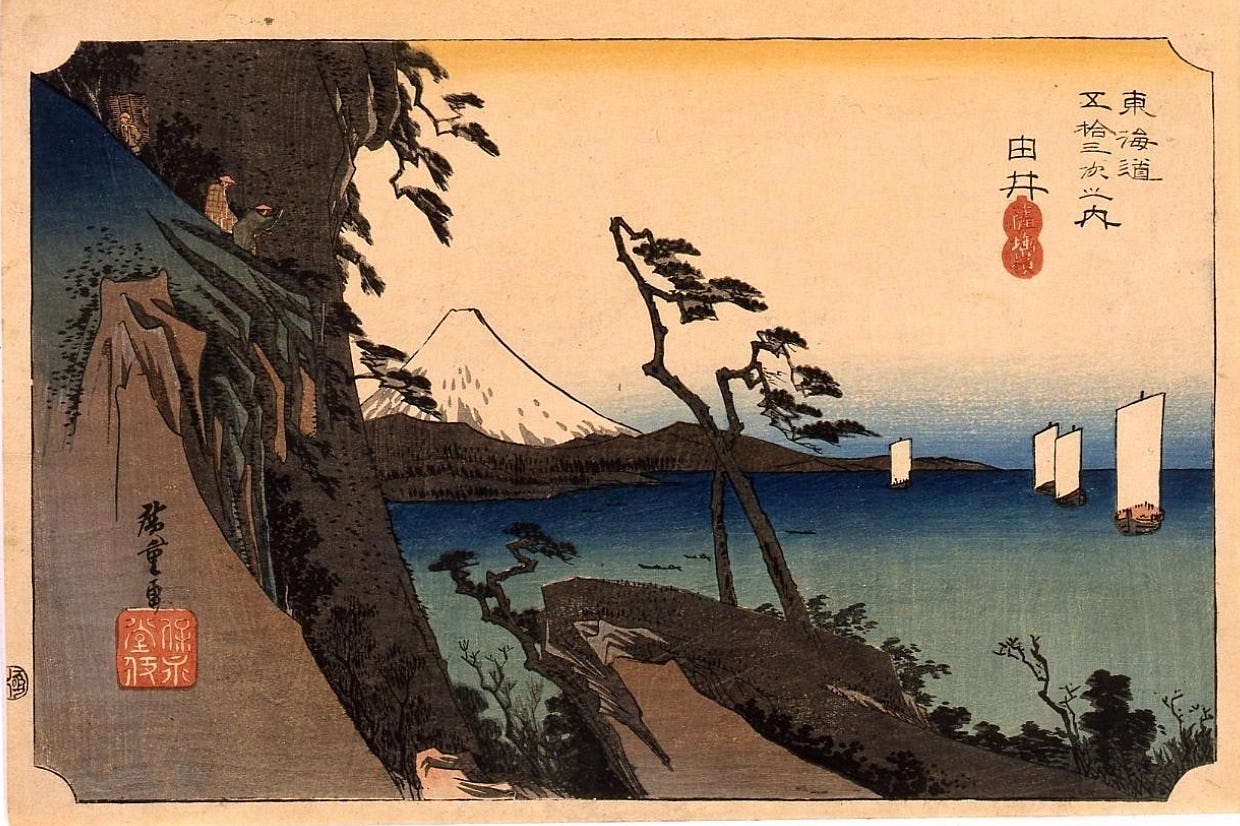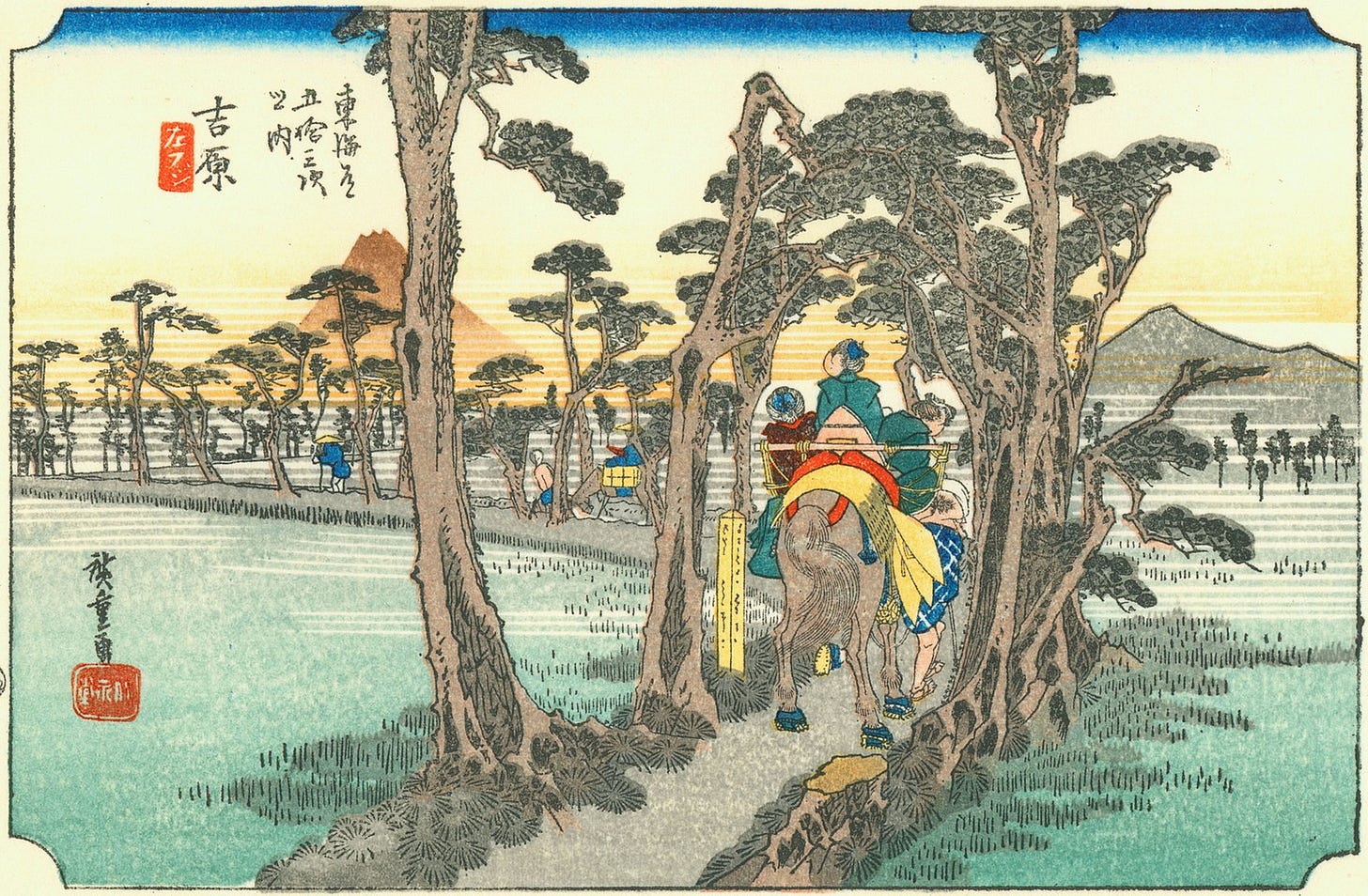Breaking the Wa (the expected order of things)
From Okitsu to Yoshiwara along the Tokaido Old Road
Staying in the same hotel for two nights meant that for the first time I could take great pleasure in dumping most of the contents of my backpack onto the bed and just carry what I needed for the day. No sleeping mat to clip passing objects, no bivy bag filling the bottom of the backpack with its giant chipolata sausage shape, and no bag of stinking worn clothes. A sign on the firedoor at the end of the corridor advertised views of Mount Fuji. I hesitantly opened it, hoping I wouldn’t set off an alarm, and was rewarded with a faint outline of Mount Fuji, the only time I would see it.
Breakfast, like the rest of the hotel, was aimed at the visiting Japanese engineer or technician. Miso soup, rice, fish - no feminine sweet breads or yoghurts, the pale-green or grey-suited men kept themselves to themselves in the school cafeteria-like dining room while a woman fussed around refilling the rice and soup pots.
Back in Okitsu, I left the station with a spring in my step. My bag was light, the bottom of my feet now like the vacuum-sucked bags for packing winter futons away during the summer months, thick and hard with tough folded-over ridges. I’d remodeled my feet.
I had expected a day of walking alongside the Route One and railway alongside the sea, similar to the end of the previous days walking. Instead, the Tokaido leapt up the side of the mountains, past orange trees and past-their-best hydrangea spilling over ramshackle houses, until the road ended at some toilets and a graveyard, which appropriately marked the start of the Satta Pass.
The pass balanced precariously on the sides of the mountains overlooking the sea, so I had an overhead view of Route One and the railway. The views were spectacular, the sea breaking on tetrapods far below, but Mount Fuji sadly lay hidden by cloud and haze. I was energized by the views, the lightness of my pack and the variety of underfoot terrain. I bounded along, past the orange tree terraces, until the path once again became a road and dropped down to the coast.
Hiroshige’s impression of the path over the Satta Pass. It looks precarious here, but the original route went directly alongside the sea, where travellers were frequently swept away by waves. The route over the mountainside was considered to be safer!
Somewhere, Expressway One had burst out of the mountainside under Satta Pass and now joined the Tokaido Mainline railway and Route One alongside the sea, the Tokaido trapped in a narrow street behind them all. Two faded shrimp on a blue archway announced the entrance to the town of Yui. The fishing port for Yui was scooped out in a gap between Route One and Expressway One.
It was only mid-morning, and I decided to take a break in Yui in a convenient shelter just next to the bridge over the Yui River. I had wanted to see the Tokaido Hiroshige Art Museum, but sadly it turned out to be closed.
Four huge pipes running down the mountain to a power station marked the outskirts of Fuji City, an industrial sprawl encompassing my hotel and the Fuji River. First up, a huge chemical plant, then an electrical works, the Tokaido crept up the mountains to one side of the Fuji River giving an overview of all the industrial plants lined up on the river plain. I crossed the green trusses of the Fujikawa Bridge and entered the city proper.
The centre of Fuji City was like the Wild West. Nothing seemed to be open. The streets were deserted. The heat intolerable. It was early afternoon - lunchtime, yet nowhere seemed to be serving lunch. Everything seemed to be geared for nighttime - snack bars, karaoke bars, izakaya pubs. Finally I found a place that advertised itself as a Bistro, but only seemed to be serving French toast - or eggy bread as we call it where I’m from. The owner came out of the door and announced:
“No food here!” in English.
“Even though it’s written here you have French toast!?” I countered in Japanese.
“Ah, yes, we have that, but that’s all.” He replied in Japanese.
Probably, he’d taken me for a tourist visiting Mount Fuji. They must get a lot here, although I never saw any the whole time I stayed in Fuji City. Just up the same street is a popular spot for taking photos of Mount Fuji, the lights of Fuji City’s main drag contrasting with the brooding snow-capped presence of Fuji-San. Those looking at the photos are unaware what a dump the centre of Fuji City really is.
By speaking Japanese I’d broken out of my allotted role. The perplexed tourist looking for Mount Fuji was what the owner was familiar with, and felt comfortable with. My intrusion into this world caused an uncomfortable silence. The only other customer left. I ate my French toast slowly while the baseball played on TV in the background.
On I went, past the Oji Material factory, slap bang in the centre of Fuji City with its own sewage works, then wiggling this way and that across the city’s grid system to approach once again my hotel. As the Tokaido turned a corner, I came face-to-face with some of the tackiest architecture I’ve seen in my life. Skegness and Blackpool have nothing on this. Right next to a historic street, a gaudy purple and every other loud-and-flashy-colour-you-can-think-of Arabian Nights building, complete with onion domes and Aladdin and Jasmine riding on the magic carpet. The thing was, it looked almost new, it was no fading relic, and yet it was still aggressively looking for new tenants.
I arrived back at the hotel pleased with myself. I was back on track, tomorrow Numazu and then the part I was looking forward to - crossing the pass to Hakone. I went out again for dinner. The whole of Fuji City seemed to suffer from a lack of restaurants and a surplus of night-life. I had searched for a restaurant on my phone and found an interesting looking Philippines restaurant nearby. I’d never eaten Filipino food before, so I was looking forward to it. I found the place, which seemed to have construction work going on nearby, walked inside, and found a stiflingly hot and stuffy bar. No one was around.
“Hello?” I called, but nobody answered.
I walked back outside.
A hostess-looking woman with dyed blonde hair called out to the construction worker:
“There’s an English teacher looking in the bar!”
An English teacher? How dare she be so presumptious and yet so accurate!
I found a bar/restaurant on the next street. The owner kindly put me in a corner as some other (more important) customers were coming in later. The food was good and I happily ate it and drank my umeshu plum liqueur while the owner chatted to his expected customers and ignored me. Again, it seemed, I had broken the expected order of things. The owner had expected a nice evening chatting with his two friends, and in I’d blundered to mess things up!









I need to know what purple Arabian building is.
While I cannot say that I have ever, or likely will ever, visit Fuji City, an industrial dump is precisely what I’d expect simply from the name. The locals likely couldn’t resist destroying something in the shadow of national greatness.
I’ve never had good Filipino food. The restaurant owners seem to not know that cooking oil must be changed.
Skegness... I don't know the place, but I like the name. Skegness... It sure sounds like a dump!